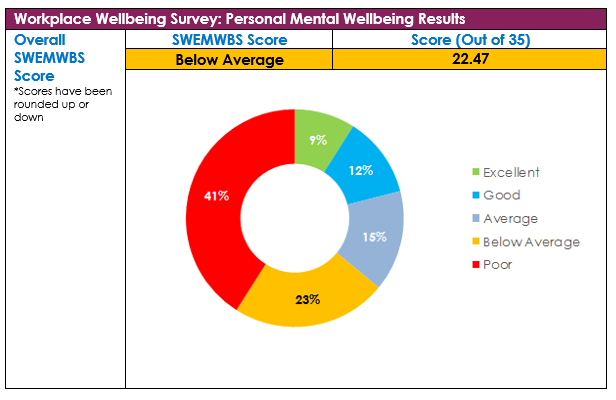
Two-thirds (64%) of workers have poor or below average mental wellbeing
Employees call for radical new approach with almost half of workers (49%) wanting a yoga and meditation room and exercise facilities (50%) to help tackle workplace stress
For International Stress Awareness Week, 5th ‘ 9th November 2018, a new nationwide survey of the country’s employees has revealed that two-thirds of employees (64%) have ‘poor’ or ‘below average’ mental wellbeing according to the Short Warwick-Edinburgh Mental Wellbeing Scale (SWEMWBS)[1].
The research, conducted by The Stress Management Society and commissioned by workplace consultants, Peldon Rose reveals a stress epidemic amongst the country’s workforce with over a third (36%) of people saying their workplace stress has been on-going for the past five years.
With three-quarters (75%) of people in a sedentary occupation and a third (36%) of people working nine hours or more a day, employees are increasingly aware of the detrimental impact their long hours and physical inactivity is having on their mental health and almost half (46%) state a lack of time to focus on wellbeing and exercise is a leading cause of stress in their workplace ‘ only behind increasing workloads (56%).
Understandably, employees are calling for businesses to take a radical new approach to help them tackle stress; half of workers are calling for the introduction of a yoga and meditation room (49%) and exercise facilities (50%) in the office followed by heating and ventilation (44%), quiet working areas (42%) and breakout spaces (38%).
Survey Highlights: Mental wellbeing: Two-thirds of employees (64%) have ‘poor’ or ‘below average’ mental wellbeing; 41% have ‘poor’ mental wellbeing according to the SWEMWBS scale.
Time out: Half of all workers (48%) say that they have taken a day off work for their mental health. Middle aged workers (35 – 50) are particularly likely to have done this with 53% saying they have compared with 43% of younger workers (18-34)
Causes of stress: ‘Increasing or heavy workloads’ (56%), ‘limited time to focus on wellbeing’ (46%) and ‘poor, slow or out-of-date technology’ (37%) are the leading causes of workplace stress
Workplace solutions: 95% state their physical work environment is important for their wellbeing and mental health but half say their current working environment doesn’t have a positive effect on their mental health (51%), wellbeing (49%), mood (47%) and productivity (43%)
Time to change: A quarter of respondents (26%) feel that their organisations do nothing to help their employees manage stress in the workplace. Only half (52%) say their office environment supports them to take regular breaks, a third (37%) that it encourages them to exercise and a quarter (26%) that it encourages them to meditate.

SWEMWBS Score: Excellent (29+), Good (27-28), Average (25-26), Below Average (22-24), Poor (7-21)
Assessing and reforming the office environment is an essential first initiative for businesses that want to maintain a healthy, productive workforce. Based on Peldon Rose and The Stress Management Society’s expertise and feedback from the survey, they have created four key initiatives for businesses to help reduce stress in the workplace and improve employees’ mental wellbeing.
Encourage exercise: The link between exercise and mental wellbeing is well understood[2]; physical activity has been shown to decrease overall levels of tension and elevate and stabilise mood[3]. However, half (46%) of employees cite lack of time to focus on wellbeing and exercise as a leading cause of workplace stress, and only a third (37%) state their work environment supports them to exercise. Employers should respond to workers’ calls for facilities that encourage exercise (50%) and yoga and meditation (49%) by assessing whether the workplace can be adapted to accommodate them. A workplace assessment will help businesses decide if an unused meeting area could be transformed into a meditation room or shower and changing facilities, or if the layout could be changed to encourage people to move around the office more. A strategically placed coffee machine or recycling point, for example, will make people more mobile, active and social.
Wellbeing time: Taking a few minutes to meditate every day with the goal of becoming more mindful, or focused on the present, is a great way to relieve stress. Yet over half of employees (54%) say their employers do not support mindfulness or meditation. This is a false economy as being relaxed and stress free helps the mind work more efficiently and reduces anxiety. Employers should ensure that supporting mental wellbeing is a key part of their company culture and that meditation and other relaxation techniques are publicly encouraged. To help create a happy and productive workforce, businesses should also incorporate relaxation zones and quiet areas as well as ensuring plenty of access to natural light.
Update technology: A third (37%) of workers cite ‘poor, slow or out-of-date technology’ as a leading cause of workplace stress. Employers must ensure that workers’ jobs are being helped not hindered by technology by investing in the technology that will best support employees to do their jobs.
Supportive workplace culture: With 95% of workers stating their physical work environment is important for their wellbeing and mental health businesses must understand what is and isn’t working for employees in the office environment. The happiest workplaces are ones that accommodate all office personality types and include a large variety of areas for employees to choose from depending on their mood and type of work. Employers should engage directly with employees through a number of methods, including focus workshops, collaborative sessions, interviews, and day-in-the life studies ‘ and, wherever possible, implement the required changes. This will help create a positive and supportive office environment around the company’s greatest assets ‘ its people.
Jitesh Patel, Chief Executive at Peldon Rose, leading workplace office design specialists commented:
‘This new research is an urgent wake up call for employers to start assessing what their people and business really need to be healthy and productive, and start addressing the concerning levels of stress amongst the nation’s employees. Workers are appealing to employers to help them to build time into their working day to focus on exercise and wellbeing and to provide the right office environment to facilitate this. Employers must listen, stand back and introduce the necessary, bold, new changes that will transform the culture and mental health of their workforce.’
Neil Shah, Chief De-stressing Officer, The Stress Management Society commented:
‘I am a massive believer that going to work should make you healthy. Most organisations want to reduce or mitigate the amount of stress or poor wellbeing they cause their employees ‘ how about turning that on its head so going to work boosts your wellbeing and is good for your mental, physical and emotional state. As the pressures and demands of life just keep increasing and the pace of life continues to accelerate more and more people are finding themselves overwhelmed. The consequences of this are far reaching, both to the individual, the team and the organization. It is clear that if we want our organisations to succeed and thrive we need to focus on our most important asset ‘ our people. Aligning people, culture, wellbeing strategy with the physical environment is critical to the success of this. There is no one size fits all solution ‘ we want to see more organisations offering different and innovative ways to give people the culture and physical space to maximise their wellbeing.’
[1] The Short Warwick & Edinburgh Mental Wellbeing Scale (SWEMWBS) is calculated through seven questions about an individual’s emotions, quality of interpersonal relationships and psychological functioning over the past two weeks. A score of 24 or below is ‘below average’, 64% of survey respondents had a score of 24 or below, 41% had a rating of ‘poor’
[2] https://www.nhs.uk/conditions/stress-anxiety-depression/mental-benefits-of-exercise/
[3] https://adaa.org/understanding-anxiety/related-illnesses/other-related-conditions/stress/physical-activity-reduces-st



















